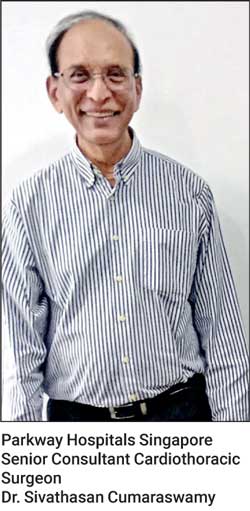Monday Dec 22, 2025
Monday Dec 22, 2025
Tuesday, 5 March 2024 00:01 - - {{hitsCtrl.values.hits}}
It pumps the blood out of the heart, pumps it back into the body and restores the normal blood flow. So the patient can run, travel, go back to work, and drive a car. Otherwise these are patients who are bedridden, they can’t eat much, and can’t breathe well
 By Fathima Riznaz Hafi
By Fathima Riznaz Hafi
Coronary heart disease, viral infections, and hereditary conditions may cause heart failure, which is a condition in which the heart is damaged or weakened; and when heart failure deteriorates further to advanced, or end-stage, conventional heart treatment such as medication, are no longer effective.
Patients with advanced heart failure can no longer enjoy basic functions that people normally take for granted, like going for walks and tying their shoe laces; instead, they find themselves facing disabling symptoms such as shortness of breath, when they attempt to do the simplest of tasks, such as walking towards their car or lifting things. They also experience swelling, and persistent fatigue.
The solution for people with end-stage heart failure is heart transplantation. Unfortunately, the demand for organ transplants far exceeds the supply, with the waiting list continuing to grow.
“There are so many patients who need a transplant but can’t do so because the waiting list is too long and the patient can’t wait too long,” says Parkway Hospitals Singapore Senior Consultant Cardiothoracic Surgeon Dr. Sivathasan Cumaraswamy.
“And for many patients, transplant is not even an option – they are patients who need a transplant but are not fit enough to undergo the surgery because they are too old, weak, or have other conditions like kidney or lungs ailments. These patients are then placed as having long-term illness – what we call ‘destination illness’.
Not being viable candidates for transplant, they remain bedridden till death. “There is no option for them – most of them will perish within six months,” he said.
HeartMate III
Fortunately, now, a heart pump called ‘HeartMate III’ brings a new lease on life for those patients. This artificial pump is used specifically for patients who have advanced heart failure problems. Designed to improve the quality of the patient’s life, with less complications, this pump will be with them for the rest of their lives, and enable them to carry out their regular activities smoothly.

Mechanical pump HeartMate III
Dr. Sivathasan Cumaraswamy, in an interview during his recent visit to Colombo, spoke about how HeartMate III can remarkably improve a patient’s quality of life and help them live the rest of their lives fitter and stronger.
How it works
The HeartMate III pump utilises technology to reduce trauma to the blood passing through the pump while improving flow. “It pumps the blood out of the heart, pumps it back into the body and restores the normal blood flow. So the patient can run, travel, go back to work, and drive a car. Otherwise these are patients who are bedridden, they can’t eat much, and can’t breathe well,” explains Dr. Cumaraswamy.
Before surgery they can hardly climb stairs – they get breathless. After surgery they can climb two floors easily; many patients go on holiday
Does the energy level get back to normal or just improve?
“Before surgery they can hardly climb stairs – they get breathless. After surgery they can climb two floors easily; many patients go on holiday,” he replied.
“They can do all this with the pump inside; they have to carry a bag, with two batteries wherever they go.”
The only drawback is the electric cable that comes out of the pump. “There is a wire and they have to take care of it. If it accidentally gets pulled it damages the skin and then the skin gets infected; then it becomes a big problem; so we have to prevent the wound getting infected. The wire is a foreign body and when we have a foreign body it doesn’t heal well. The common problems are – sometimes the wire gets caught to a door knob or other objects. Also, they cannot jump into a swimming pool – but they can have a shower.”
How do we have that shower? Is there something used specifically for that?
“No, just go to the supermarket and buy a cling wrap, wrap it around. The electrical components just have to be covered by something water-proof where all the batteries are protected, and then it’s safe to have a shower,” he said.
This may seem inconvenient but Dr. Cumaraswamy asserts it is far better than living on a bed and waiting to die in six months.
How long do HeartMate III batteries last?
The HeartMate III LVAD uses rechargeable batteries that provide up to 17 hours of support. The batteries drain simultaneously and require four hours to charge. The patients are given a portable charger so they can charge the batteries anywhere. “The best time to charge is while they are sleeping,” Dr. Cumaraswamy suggested.